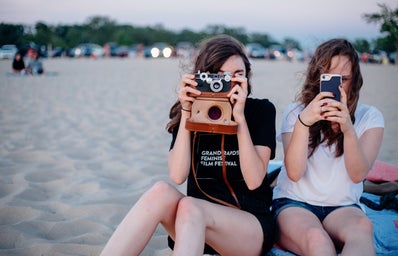How Do You Get Pictures From A Disposable Camera On Your Phone? – Full Guide
You could have assumed that disposable cameras were no longer available. With the widespread use of high-end, digital photography on mobile phones, it’s easy to dismiss disposable cameras as obsolete. These cameras, believe it or not, are still in use today! Too many individuals still use these disposable cameras for social events, underwater diving, or high-end experimental films as a hobby.
However, rather than processing and archiving those images, many of them are opting to go green by transferring them to digital devices such as smartphones or PCs. Is it feasible to convert images taken with a disposable camera to digital format? If that’s the case, how can you get photographs from a disposable camera onto your phone? This is probably a possibility. In this article, we’ll show you how to accomplish it quickly and easily on your own. So keep reading!
Disposable Cameras: What Are They and Why Are They Making a Comeback?
With the popular disposable film camera in the late 1980s, photography became more informal and easygoing. It was no longer essential to carry around a bulky, expensive camera and four rolls of film in your pocket. You could keep a cheap disposable camera in your pocket at all times and never miss a wonderful moment or beautiful landscape. Disposable cameras are compact box cameras designed for use by amateur photographers in harsh conditions.
After losing ground to digital cameras and smartphones for a while, disposable cameras are making a comeback thanks to a growing interest in film photography, as well as its durability, waterproof capabilities, lack of a rechargeable battery, and reduced price. There are also numerous locations where disposable cameras can be developed. Use Walgreens, Walmart, or CVS if you don’t want your negatives returned and don’t care about high-quality scans.
However, I prefer MPIX.com, TheDarkroom.com, or OldSchoolPhotoLab.com if you do want your negatives returned. You may be perplexed as to why somebody would return to outdated technologies rather than progress. We’ll go over the trend and why individuals are adopting disposable cameras further down.
What’s the Point of a Disposable Camera?
Nowadays, we all have cameras on our phones and tablets. However, taking images using a disposable camera is still a frequent habit. These small disposable cameras are capable of taking all-encompassing photographs that produce stunning images.

Camera for Disposal
Anyone with a smartphone can take images with a throwaway camera. Disposable cameras range in price from $15 to $35 and are ideal for photographing occasions such as a friend’s birthday celebration or a live performance. Those who enjoy travelling and taking photographs may find themselves needing to capture photographs even underwater. While waterproof cameras and digital phones are available, they are prohibitively pricey for most people.
In this regard, waterproof disposable cameras are available. They’re well-known among underwater photographers who want to capture unusual sceneries and breathtaking views. However, when you wish to share such memories on social media, the difficulty arises. They’re all Kodak or similar analogue photos that need to be developed! Is it feasible to download images taken with a disposable camera to your phone? Although it is not possible to transfer photos straight from a disposable camera to a phone, there are a few methods you can use in the meantime.
Easy Methods To Take Disposable Camera Pictures From Phone
Method 1: Scan the Developed Photos
This system will need to be improved, and you will have to invest some money in it. Because disposable cameras capture pictures on film reels, you’ll have to choose which ones you want developed. Developing costs money, therefore developing a small number of images will save you money. Open the Kodak or Fuji negative films and place them in front of a light source. Examine the negatives and determine which of the images you’d like to develop.
Choose your photos and take them to a nearby film developer. After that, you’ll require a scanner. If you already have one, that’s fantastic! Otherwise, you may be able to find scanning services in some stationeries. There are other low-cost scanners on the market that can be used just for this purpose. Connect the scanner to a computer and scan the photos that have been developed. Once you’ve downloaded them to your computer, you can quickly transfer them to your phone using the internet or a USB port.
Method 2: Scan the Negatives Directly
This is an intriguing idea, but it will necessitate considerable Photoshop and photo editing expertise. Place the negative image of the desired photo in the scanner’s centre. Place a standard white piece of paper on top of the negative and a desk lamp or other source of light 4 to 5 inches above the paper and negative. The scanner lip does not need to be closed; instead, it should be left open. Turn on the scanner and take a high-resolution scan of the photo.
Save the image and alter it with a photo editing programme. The image will seem inverted or inside out in depth as well as colour when scanned. To restore the original image, use the “Positive Exposure” tool to invert the scanned image once more. You now have the desired photograph in digital format. You can save and transfer it to your phone in whatever way you choose.
Method 3: Take a Photo of The Developed Picture With Your Phone
As previously stated, have the photos developed routinely as you have in the past. Bring the images home and display them in a well-lit room, preferably on a table. Take out your smartphone, launch the camera app, and take pictures of the developed images.
Ensure that the light from the processed images does not reflect on the camera. Take a snap as close to your subject as you can with a steady hand. Take as many images as you want until you’re satisfied with the likeness. For even more precision, look for cam scanning programmes in the app stores.
Method 4: Ask The Photo Lab To Transfer The Photos in Digital Format
This is the simplest method because numerous photo labs presently provide film digitalization services. You can request that they put the photos on a CD/DVD or a flash drive for you. You may also have them sent to you by email. In any event, you may quickly move such photos to your phone by downloading them from the CD/DVD or email. Small box cameras with preloaded film and, in some circumstances, a built-in flash are known as disposable cameras.
They’re simple, low-cost cameras that take the trouble out of photography for folks who don’t want professional-quality images. The term “disposable” refers to a camera that is intended to be used once and then discarded. Not all disposable cameras are now tossed in the trash; those with pre-loaded film are mailed off to be developed. Those cameras are occasionally refilled and resold.
After the film has been retrieved and removed, the cameras are sometimes discarded. Those that do not have preloaded film can be replenished and used again by the consumer. The original disposable camera used an eight-exposure film; modern film cameras use between twenty-four and twenty-seven exposures. As a result, they’re great for taking on.
- Vacation
- road trips
- adventures
- anywhere you might want to quickly capture photos without needing professional quality.
A digital disposable camera has the capacity for about twenty-five photos. Add a memory card and the capacity increases by thirty photos.
Why Are Disposable Cameras Coming Back?
Millennials are returning to the simple, disposable film camera after exhausting the filter options on phone cameras without ever finding the ideal one, and not wanting to invest in big digital cameras that will be wrecked by one drop. Why would you want to go back to analogue film now that you’ve seen the clarity and simplicity of digital? Disposable film cameras are making a comeback for a variety of reasons.
- The absence of a filter indicates that the image is genuine.
- Because there are no preview or delete options, you will get exactly what you filmed.
- Due to the limited amount of exposures, you must be selective in what you photograph.
- The element of surprise adds to the enjoyment of seeing your photos once they arrive.
- Print photographs can be shared in ways that digital photographs cannot. With analogue film, you capture the moment exactly as it is, without the need for retakes.
Often, we find that the older method is the best, and this is absolutely true with disposable cameras. To capture their memories, more individuals are turning to the simple disposable camera of the past. That bright, blurry photo transports me back to a time when we didn’t feel compelled to record every meal and document every moment. Because of the limited amount of shots we have, the scenes we select to spend our limited number of shots on have greater significance.
We capture the realness and rawness of the scene as it happens with a disposable camera. We can’t just retake the picture because someone’s hair wasn’t quite right or because someone closed their eyes just as the camera clicked. It’s just the way it is. After two decades of displaying doctored images for the world to see, the vulnerability of those moments is what brings us back to utilising the disposable film camera. Finally, we return to simply being ourselves and savouring every moment.
 Kodak Waterproof Disposable Camera
Kodak Waterproof Disposable Camera
Why Do Disposable Cameras Exist?
People invented disposable cameras so they could capture memories of scenes or moments without having to worry about breaking or losing their expensive camera. Disposable cameras encapsulated all of the best qualities in a compact, unbreakable container. They are as follows:
- Inexpensive
- Rugged
- There is no way to recharge the battery.
- Some are water-resistant.
- Easy-to-use, no-hassle development
These are the cameras that nature enthusiasts and explorers use on hikes and mountain climbs. Put it in your pocket and it’ll be right there when you need it, unaffected by the trail’s bumps and falls.
Who Invented Disposable Cameras?
H. M. Stiles invented the first disposable camera, the Photo-Pac, in 1949, and it cost $1.29. This camera, for some reason, never caught on in the market. After seventeen years, the French manufacturer FEX released its own disposable camera. Fujifilm introduced the popular disposable camera of the previous century in 1986. In 2004, a firm called Pure Digital debuted the disposable digital camera to the United States.
Do Disposable Cameras Take Good Pictures?
The picture quality of a disposable camera varies depending on the camera. Of course, analogue film cameras cannot compete with digital cameras in terms of image quality, but higher-end film cameras can generate a respectable image. When taken in proper lighting, some higher-end disposable cameras create brighter colours than professional cameras, and the photographs can be fairly clear.
Knowing your camera’s limitations and how to maximise its capabilities is the key to capturing nice images with a throwaway camera. 35mm film is used in the majority of disposable film cameras. The film is built-in to certain cameras, and the entire camera is mailed in for processing. Other cameras can be opened and film can be reloaded.
Best Disposable Film Cameras
See the charts below for the best 35mm and waterproof disposable cameras and where to buy them.
35mm Disposable Cameras:
| Camera Model | Color or Black and White Film | Price | Exposures | Flash? |
|---|---|---|---|---|
| Kodak Fun Saver | Color Film (400 ISO) | $13 – $15 | 27 | Yes |
| Ilford Single Use B&W Camera HP5+ | Black and White (400 ISO) | $13 – $15 | 27 | Yes |
| Fujifilm Quicksnap | Color Film (400 ISO) | $18 | 27 | Yes |
| Lomography Simple Use (reloadable) | Color Film (400 ISO) | $32 | 24-36 | Yes W/ Color Filters |
| Lomography Simple Use (reloadable) | Black and White (400 ISO) | $22 | 24-36 | Yes |
| Kodak Camera w/ Flash | Color Film (400 ISO) | $14 | 27 | Yes |
| Kodak SUC Daylight Disposable Analog Camera | Color Film (800 ISO) | $14 | 39 | No |
Waterproof 35mm Disposable Cameras:
| Waterproof Camera Model | Color or B&W | Price | Exposures | Flash? |
|---|---|---|---|---|
| FujiFilm Waterproof Quick Snap (2 pack) | Color Film (400 ISO) | $35.99 (2-pack) | 27 | No |
| Kodak Waterproof Water & Sport | Color Film (400 ISO) | $22.99 | 27 | No |
| AgfaPhoto LeBox Ocean 400 (waterproof) | Color Film (400 ISO) | $19.95 | 27 | No |
Are Batteries Included in Disposable Cameras?
Batteries are only required for disposable film cameras with flashes. Because the camera is entirely mechanical, it does not require a power supply. Those cameras with flashes typically utilise a single AA or AAA battery to charge the flash, which is usually included in the purchase and is not intended to be changed. If you have a reloadable disposable camera, the flash will not work unless you supply or replace the battery.
Disposable cameras do have an expiration date.
The camera itself does not have an expiration date, but the film and batteries for the flash do. Film normally expires 2–3 years after the production date, but if stored away from heat and humidity, it can last up to another five or six years.
While expired film can still be developed, there is no guarantee that the images will be of any quality, especially if the camera was not properly maintained away from heat, direct sunlight, and humidity. Because of film degradation and fog, colour film may lose part of its quality after the expiration date, and your negatives may be grainier, have less contrast and sharpness, and colour shifts than typical. Light leaks, colour banding, and colour changes may occur if the camera was stored in heat, direct sunlight, and humidity. Because film processing can be costly, you don’t want to waste money on lousy images.
How Long Do Disposable Cameras Last Undeveloped?
How long undeveloped film lasts is largely determined by how the camera is stored. The results will be disappointing if it is stored where temperatures change or where humidity can alter the film. If kept in a safe place,
- Heat from the sun
- Light
- Humidity
If you must keep your undeveloped camera for an extended period of time, make sure it is kept in an airtight container and kept in a dark closet or corner. This will increase your film’s chances of survival.
Most Disposable Cameras Do Not Have Timestamps
The majority of disposable film cameras lack a timestamp feature. There is no computer chip to tell the camera what date or time it is because the throwaway camera is entirely mechanical save for the flash. However, when the film is processed at the lab, this feature is available and is normally printed on the back of the print. When looking over old photos and trying to figure out when, where, and why they were taken, these can come in handy.
Tips for Getting Good Quality Pictures From A Disposable Camera
A disposable camera, when used properly, may provide vivid, intriguing photos. To get the most out of a disposable camera, as with any art form, one must understand how to optimise capabilities while minimising constraints. Follow these basic guidelines for the best results:
- As much light as possible should be used (most are made for shooting outside in bright sunlight)
- Make sure your subject isn’t backlit; in the printed shot, they’ll be in shadow.
- When utilising the flash, make sure the subject is 4–10 feet away from the camera.
- Experiment with different perspectives.
Playing with it is the greatest approach to figure out what works and what doesn’t. Practice makes perfect, and the only way to improve at something is to practise a lot.
So grab your camera and get out on the trails! Simply try different things and see what you come up with. When you understand how to maximise the possibilities of a cheap, unadorned camera, you might be astonished at the beautiful photos you can get.
Do Disposable Cameras Work in Low Light?

Because there was not enough light in this shot, it is underexposed. This person should have taken advantage of the flash.
Without a flash, disposable film cameras are typically poor in low-light situations. In low-light situations, using a flash will help, but it will not illuminate the entire scene. In situations where natural or artificial light is scarce, the flash just isn’t powerful enough to give appropriate lighting. A distance of 4–10 feet between the camera and the subject is recommended by most cameras.
 In poor light, this disposable camera used a flash, but the subject is too far away and underexposed.
In poor light, this disposable camera used a flash, but the subject is too far away and underexposed.
In the dark, disposable cameras are useless.
Disposable cameras do not operate well in low-light situations because their exposure settings are frequently left unchanged and are set up to photograph in bright sunshine. In most cases, the flash is your only option for adjusting exposure. While the camera has a flash, it isn’t powerful enough to capture sweeping landscapes or distant objects. For the flash to work correctly, your subject must be between 4 and 10 feet distant.
It Isn’t Always Necessary to Use a Flash
It’s not always a good idea to use a flash with a disposable camera. A flash might cause more harm than good in some situations. The flash is useless in strongly illuminated environments, such as outside in direct sunshine. A flash isn’t beneficial if your subject is backlit (or standing with the light behind them so their front is in shadow), because it isn’t powerful enough to capture the full person. You’d have to be closer to them for this to function. Most cameras recommend a distance of 4–10 feet.
 Back of a Kodak Disposable Camera. It suggests 4 – 10 feet range for the flash.
Back of a Kodak Disposable Camera. It suggests 4 – 10 feet range for the flash.
In addition, in nearly dark circumstances, a flash will either over- or under-illuminate the subject, resulting in either too much or too little light or detail. To get properly illuminated photographs with the camera flash, most cameras recommend a distance of 4–10 feet. You can only estimate at the correct distance because there is no ability to preview the photograph.
 The subject was too close in this image made by a disposable camera with the flash on and is overexposed.
The subject was too close in this image made by a disposable camera with the flash on and is overexposed.
Using a flash discriminately will help you shoot vibrant prints and regardless of setting can ruin what would have been a perfect picture. For some cameras, if you decide you don’t want to use the flash after you have charged it, which can be done by pressing the button the front or sliding a button if you will have to discharge the flash.
How to Clean the Lens of a Disposable Camera
Camera lenses become dirty as a result of being exposed to the elements on the path, and they become greasy as a result of fingers accidently contacting them. If you want beautiful, clear photographs, you’ll need to clean your lens on a regular basis. Cleaning a camera lens is not difficult, but it does necessitate a gentle touch. During cleaning, the lens is easily scratched, especially if it has been exposed to dust and sand. To clean the lens, follow these steps:
- To remove as much loose debris as possible, blow on it or brush it with a soft-bristle brush.
Use a lens cleaning solvent and a soft cloth to clean your lenses.
Wipe the lens clean with a soft cloth to remove any grease or fingerprints.
How To Use Kodak Or Fujifilm Disposable Cameras
To operate your Kodak or Fujifilm camera, simply wind the thumbwheel until it stops turning, then press the shutter button.
 Back of a Fujifilm disposable camera. See the thumbwheel on the top right.
Back of a Fujifilm disposable camera. See the thumbwheel on the top right.
If your camera has a flash, press or slide the flash button until the light turns red, indicating that the capacitor has been charged. Simply point your camera at your subject, gaze through the viewfinder until your focus is where you want it, and hit the exposure button on the top of the camera.
Most cameras recommend a distance of 4–10 feet between the camera and the subject while using the flash. Wind the thumbwheel until the next number displays in the window on the top of the camera after taking an image to take the next photograph.

A Fujifilm disposable camera’s exposure counter window.
Continue until you’ve exposed all of your frames. Then, to obtain your photographs, submit your camera to the lab of your choice.
Retrieving Your Images from A Disposable Camera
Most, if not all, one-hour photo labs from the 1990s are no longer in business, but labs that can develop your film and give digital scans of your photographs (and negatives) so you may transfer or download them to your phone still exist. It takes time to recover your photographs from your disposable camera. You just turn in the entire camera for disposable film cameras, and the photo lab removes the film, develops the negatives, scans them, and, in certain circumstances, refurbishes the camera.
You can also check acrylic magnetic photo frames for your photos.
Can Disposable Cameras Freeze?
Disposable cameras can work in sub-zero conditions with little difficulty. There is no risk of condensation shorting circuitry in a disposable film camera because it has few, if any, electronic components. You can cover the camera in a freezer bag to prevent the exterior shell from freezing and shattering. Allow your camera to progressively warm up after being exposed to intense cold. Color film is commonly stored in a freezer or refrigerator to prevent it from degrading over time, especially after it has expired. Disposable cameras can also be used for this.
Final Words – Disposable Camera
Whatever method you use to capture your memories, taking photographs is a fun and exciting way to save unique moments for a lifetime. In addition, employing a disposable camera is an excellent alternative for preserving those memories in both print and digital media. After learning how to download disposable camera images to your smartphone, there is nothing stopping you from shooting photos and sharing them with your friends and family!




